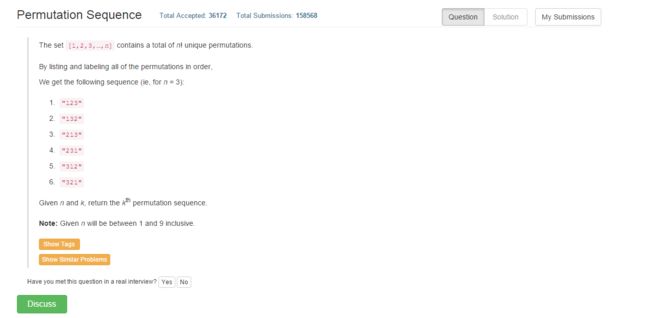My code:
public class Solution {
public String getPermutation(int n, int k) {
if (n <= 0)
return null;
int temp = n;
int total = 1;
while (temp > 0) {
total *= temp;
temp--;
}
if (k > total)
return null;
boolean[] isVisited = new boolean[n + 1];
return getResult(n, k, n, isVisited);
}
private String getResult(int n, int k, int curr, boolean[] isVisited) {
if (curr <= 1) {
int temp = 0;
for (int i = 1; i <= n; i++) {
if (!isVisited[i]) {
temp = i;
break;
}
}
return Integer.toString(temp);
}
int temp = curr - 1;
int total = 1;
while (temp > 0) {
total *= temp;
temp--;
}
int group = (k - 1) / total + 1; // divide the group
int count = 0; // count the group including the consideration of visited group
int begin = 0;
for (int i = 1; i <= n; i++) {
if (!isVisited[i]) {
count++;
if (count == group)
begin = i;
}
}
isVisited[begin] = true;
String beginStr = Integer.toString(begin);
k = k - (group - 1) * total;
return beginStr + getResult(n, k, curr - 1, isVisited);
}
public static void main (String[] args) {
Solution test = new Solution();
System.out.println(test.getPermutation(4, 2));
}
}
My test result:
这道题目感觉和 Next Permutation 有一些关联。然后我自己做出来了。
主要就是,按照顺序排列后,每一列,都是按照大小排列的。
我可以根据,k, 算出 这个数字所属的块,我称之为,group.
然后,在进入这个group后,还会再分块,再进入group中的子group。
然后,开头的字母,都是按照大小顺序排列的。
我可以计算出,开头字母,在这个大group中的偏移位置 group。
然后,这个位置只可能出现 ,1...n,中的一个,然后按照大小排列,第 group 个数字,就是我要的开头字母。
但是还需要考虑一个情况,就是有些数字已经在之前使用过了。
所以要设置一个布尔数组 isVisited[], 访问过了就设置为true,下次遍历,就不再访问了。
然后就顺理成章了。
**
总结: backtracing, Array, 通过布尔数组 isVisted 来避免已经出现的情况再次出现。
**
Anyway, Good luck, Richardo!
My code:
public class Solution {
public String getPermutation(int n, int k) {
if (n <= 0 || k <= 0)
return null;
/** calculate n! */
int total = n;
for (int i = n - 1; i >= 1; i--)
total *= i;
StringBuilder ret = new StringBuilder();
boolean[] isVisited = new boolean[n];
helper(k, n, n, total, isVisited, ret);
return ret.toString();
}
private void helper(int k, int n, int level, int total, boolean[] isVisited, StringBuilder ret) {
if (level == 1) {
for (int i = 0; i < n; i++) {
if (!isVisited[i]) {
ret.append(i + 1);
break;
}
}
return;
}
else {
total = total / level;
int group = k / total;
if (k % total != 0)
group++;
int counter = 0;
for (int i = 0; i < n; i++) {
if (!isVisited[i]) {
counter++;
if (counter == group) {
ret.append(i + 1);
isVisited[i] = true;
break;
}
}
}
if (k % total == 0)
k = total;
else
k = k % total;
helper(k, n, level - 1, total, isVisited, ret);
}
}
}
这是我写的版本,比较复杂冗杂。
主要一个问题没能很好解决。
就是取出一个数字进入字符串后,剩下的以后还得按序选,根据算出来的偏移。
所以我设置了一个boolean[] isVisited来进行这个操作,配合一个计数器,counter
当 counter == 算出来的偏移量后,就取出来放进字符串。
同时,k的更新也是有讲究的。反正整体是比较复杂的。下次写还是不能保证一次通过。
所以参考了网上的代码,感觉很简洁,思路也很清晰。
My code:
public class Solution {
public String getPermutation(int n, int k) {
if (n <= 0 || k <= 0)
return null;
ArrayList bag = new ArrayList();
for (int i = 1; i <= n; i++)
bag.add(i);
/** calculate n! */
int total = 1;
for (int i = 1; i <= n; i++)
total *= i;
StringBuilder ret = new StringBuilder();
k--; // change k to be the index
while (n > 0) {
total = total / n;
int offset = k / total;
ret.append(bag.get(offset));
bag.remove(offset);
k = k % total;
n--;
}
return ret.toString();
}
}
这道题木接触了两个新东西。
每次取出来一个数后以后不能再取了。可以放在一个list里面,取出来之后就把他删除了。这样以后就不会再用到了。然后后面的element会移动到前面,所以可以满足这么一种效果。
k本来表示的是个数,很多地方用起来很不方便!需要分类讨论。但是k-- 把他改成index之后,所有的都变方便了,不需要再把代码写的和之前一样的复杂了。妙!
参考网页:
http://www.programcreek.com/2013/02/leetcode-permutation-sequence-java/
Anyway, Good luck, Richardo!
My code:
public class Solution {
public String getPermutation(int n, int k) {
List bag = new ArrayList();
for (int i = 1; i <= n; i++) {
bag.add(i);
}
int total = 1;
for (int i = 1; i <= n; i++) {
total *= i;
}
StringBuilder ret = new StringBuilder();
k--;
while (n > 0) {
total = total / n;
int offset = k / total;
int digit = bag.get(offset);
ret.append(digit);
bag.remove(offset);
k = k % total;
n--;
}
return ret.toString();
}
}
没做出来。虽然思路还是和以前一样。
主要的一个问题还是 offset 和 真是的位置一直分不清楚。虽然我也想到了 k--
首先k--, 将它转换为index,之后再做。
还有个操作就是用list存 1-9,用一个删除一个,这样后面的可以靠过来。虽然这么做开销挺大,但考虑到一共是 1-9,可以默认,开销为O(1)
Anyway, Good luck, Richardo! -- 09/05/2016

